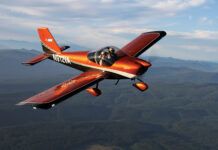 Question: I know that you are active on the Van’s Air Force (VAF) site, so I thought I might direct some questions to you about what issuing an “Airworthiness Certificate” (FAA Form 8130-7) in the Experimental category actually means in the U.S. In a recent thread on standards of RV build quality, a poster made the following comment that caught my eye. He said, “If the FAA or whatever authorizing agency that grants your airworthiness certificate and sets the minimum standards says the aircraft is safe, then go with it.”
Question: I know that you are active on the Van’s Air Force (VAF) site, so I thought I might direct some questions to you about what issuing an “Airworthiness Certificate” (FAA Form 8130-7) in the Experimental category actually means in the U.S. In a recent thread on standards of RV build quality, a poster made the following comment that caught my eye. He said, “If the FAA or whatever authorizing agency that grants your airworthiness certificate and sets the minimum standards says the aircraft is safe, then go with it.”
This comment may reflect a broadly held misconception in the Experimental category that when a DAR issues a Special Airworthiness Certificate, he is doing so after an FAA prescribed rigorous inspection of the project to ensure it is safe for flight in all aspects. The comment seems to imply that it is the DAR’s responsibility to ensure “airworthiness” and minimum safety standards rather than the builder’s sole responsibility. Such a belief might lead a builder to believe that any shortcoming in his build quality affecting safety will be picked up by the DAR.
Answer: You are correct in that the DAR does not inspect the aircraft to assure minimum safety standards. The builder does that. The responsibility of the DAR is to assure that the aircraft meets the requirements of FAR 21.191(g) or 21.191(i), as the case may be. After saying that, I do inspect the aircraft to ensure that it does not have issues that would make the aircraft unsafe. But that is not my job. I do it as a courtesy to the applicant. Different DARs inspect to different depths. Again, the primary responsibility of the DAR is to ensure that the aircraft meets the definition of the relative FAR.
Question: When you issue a Special Airworthiness Certificate, are you stating that the aircraft is airworthy? I would imagine that “airworthy” is impossible for an Experimental aircraft because there is no type certificate that “airworthiness” can be measured against. The FAA Form 8130-7 Special Airworthiness Certificate is, therefore, actually a misnomer.
Answer: The term “airworthy” is used loosely in the Experimental neighborhood to mean, “In a condition for safe operation.” You are correct in that Experimental aircraft can never meet the true definition of “airworthy.”
Question: When issuing a Special Airworthiness Certificate, is the DAR responsible for inspecting the aircraft to fully determine the integrity of the design and the construction and identify any structural design or construction deficiencies?
Answer: The DAR is not responsible for determining the integrity of the design or construction of the aircraft. However, if I see something that really scares me, I have the right to deny the airworthiness certificate for anything unsafe. In that case, the applicant has the right to seek another inspector. However, all inspectors in the U.S. will be notified of my denial and the reason or reasons for such. If they feel that I was too strict with my denial, they have the right to issue an airworthiness certificate.
Question: Does the DAR need to be an A&P?
Answer: U.S. DARs must hold an A&P certificate. An exception is that if the DAR only wants to do Amateur-Built or Light Sport Aircraft, a repairman certificate may be substituted for the A&P certificate.
Question: Is the extent of the inspection before the issue of a Special Airworthiness Certificate largely at the discretion of the DAR? And might some DARs not even be inspecting an aircraft from an “airworthiness” point of view because a) they are not qualified to do so or b) they are not required to do so?
Answer: I think “most” DARs in the U.S. inspect beyond the scope of their minimum requirement as a courtesy to the applicant. When one is so close to a project, it is very easy to overlook things like short bolts, loose jam nuts, missing cotter pins, improper safety wiring, etc. We want to make sure, as much as possible, that every aircraft is in a condition for safe operation. None of us is perfect. I have certificated more than 1000 Experimental and Light Sport Aircraft and have found only four where I could not find a discrepancy.
Please send your questions for DAR Asberry to [email protected] with “Ask the DAR” in the subject line.














Mel,
Just to let you know, don’t forget (if you realize it) that DAR (mfg)’s (DAR F) are out here also and we do all airworthiness inspections and our requirements MAY be different than what a DAR (maintenance) (DAR T) can perform and are qualified to be able to do.